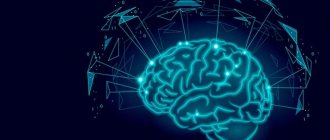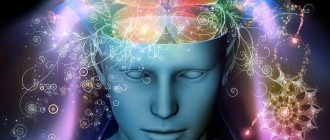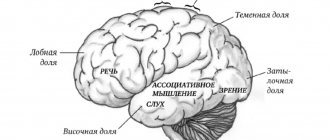- Figurative memory
- Visual memory
- Auditory memory
- Motor memory
- Verbal-logical memory
- Emotional memory Functions of emotional memory
- Features of random memory
Human memory is, in fact, an interconnected process consisting of three components: input of information (memorization), its retention (storage) and, finally, reproduction. Their relationship is expressed in the fact that the preservation of information depends on how memorization is organized, and the quality of reproduction depends on it.
This circumstance should be taken into account when deciding for yourself the problem of how to improve soldering for an adult. Based on the nature of mental activity, they distinguish between figurative, verbal-logical, motor and emotional memory.
Figurative memory
Figurative memory is a repository of sounds, smells, and visual ideas. Visual-figurative memory stores material in the form of visual, auditory and other images. Therefore, several separate types of figurative memory are distinguished, such as auditory (try to remember the purring of a kitten or the crackling of brushes in a fire), visual figurative memory (the face of a loved one or a favorite vase - remember?), olfactory (the smell of a familiar perfume or just freshly cut grass), tactile (the touch of a warm hand or the pain of an injection), taste (the sourness of a slice of lemon or the sweetness of a banana). Visual-figurative memory is especially important in creative activity.
Our brain prefers to perceive the world by processing information in both hemispheres: the right one perceives the image, and the left one selects words for it. By developing figurative memory, we fill the gap caused by the lack of images: in the modern world there is a lot of information, but the bulk of it does not involve the right hemisphere in its work, an imbalance arises, as a result of which it is increasingly difficult for us to remember, maintain attention, and concentrate. The development of figurative memory helps to engage the right hemisphere, using the imagination. By imagining, we remember easily. Having understood the material, we create an image that consolidates understanding and gain knowledge.
There are visual, auditory, motor-auditory memory, visual-motor-auditory memory. These are the types of so-called sensory memory that play the most important role in learning. Knowing what type of memory predominates in a student, you can take a differentiated approach to the process of his learning, achieving better memorization results. The teacher must ensure that as many senses as possible participate in the process of learning the material. At one time, the famous teacher K.D. drew attention to this. Ushinsky.
By the nature of mental activity
Depending on what mental activity predominates in human activity during the recording and reproduction of information, there are the following types of memory.
Motor
Other names: motor.
Definition in psychology: fixation, retention and reproduction of motor algorithms, their amplitude, duration, speed, direction. It is formed in a part of the brain called the reticular activating system.
Why is it needed: contributes to the development of a number of skills (domestic, sports, labor), as well as learning to write.
Examples:
- the simplest movements that a person learns from childhood: how to walk, hold a spoon, brush your teeth, comb your hair;
- playing tennis, team sports, swimming, gymnastics, aerobics, exercise equipment;
- knitting, embroidery;
- cutting food, peeling vegetables and fruits;
- drawing, modeling, wood carving;
- dancing;
- playing musical instruments.
Who is especially well developed: athletes, secretaries, dancers, jewelers, watchmakers, surgeons, assembly line workers.
Development methods:
- Exercise. Master different sets of exercises.
- Develop fine motor skills (sculpt, assemble puzzles and Legos).
- To take dance classes. Learn new directions.
- Develop your hands.
- Learn to play musical instruments.
- Master the ten-finger touch typing method.
- Learn to use Chinese chopsticks.
- Perform exercises that involve completely different movements with your hands (for example, the left hand strokes the table in a circular motion, and the right hand, clenched into a fist, knocks on the table).
Emotional
Definition in psychology: fixation, retention and reproduction of feelings experienced by a person, as well as emotionally charged events. They can be positive and negative. They are formed by a part of the temporal part of the brain called the amygdala. They are deposited in the cerebral cortex. Thanks to the plasticity of the central nervous system, with each subsequent reproduction of the same situation, its brightness is smoothed out.
Why is it needed: feelings experienced and recorded by emotional memory become a kind of signaling system for a person. It either encourages him to act (if the experience was positive) or deters him from it (if the experience was negative). Forms a versatile personality, develops emotional intelligence, promotes social adaptation, and stimulates creativity.
Examples:
- empathy, sympathy (based on experience);
- Love;
- complexes;
- phobias;
- choice of social circle (people move away from those who hurt them in the past).
Who is especially well developed: actors (the famous system of K. S. Stanislavsky is based on it), teachers, psychologists, representatives of social professions.
Development methods:
- Keeping a diary.
- Meditation.
- “Anchoring” positive feelings and emotions.
- Bibliotherapy.
- Master networking and make as many new acquaintances as possible.
- Do what you like.
- Adrenaline: ride a roller coaster, jump from a parachute.
This is interesting. Psychologists say that a person remembers 3 feelings best - fear, suffering, surprise.
Semantic
Other names: verbal, logical, verbal-logical.
Definition in psychology: fixation, retention and reproduction by a person of heard, seen, spoken words.
Why is it needed: allows you to record and reproduce information based on generalized associations that reflect its most important aspects. Uses large structural units for memorization, which are called mnemonic supports. After a while, they are the ones who help a person remember the material.
Examples:
- retelling;
- memorizing poems;
- preparation for exams.
Who is especially well developed: artists, singers, pupils, students.
Development methods:
- Break information into blocks and isolate main ideas.
- Read complex texts every day that are far from your interests, try to understand and remember the information contained in them.
- Before going to bed, remember in detail the past day (week, month, quarter, six months, year).
Figurative
Other names: visual-figurative.
Definition in psychology: fixation, retention and reproduction of visual and sound images, as well as odors.
Why is it needed: to control the balance of functioning of both hemispheres of the brain.
Subtypes:
Who is especially well developed: musicians, artists, writers.
Development methods:
- Master the association method.
- Do neuroscience.
- Learn foreign languages.
This classification is considered basic in psychology. Particular attention is paid to the figurative type.
Related article: How to develop memory
Visual memory
Visual memory is associated with the storage and reproduction of visual images. Visual figurative memory involves the use of a visual analyzer to process information. For many people, visual figurative memory represents the main type of memorization.
The development of visual memory is especially important for artists, but we all use it widely. By developing imagination, we also help the development of visual memory, because what we imagine is easier for us to remember and reproduce.
Individual differences in memory. Peculiarities of memory of younger schoolchildren
What is memory
What we sense and perceive does not disappear without a trace; everything is remembered to one degree or another. Excitations coming into the brain from external and internal stimuli leave “traces” in it that can persist for many years. These “traces” (combinations of nerve cells) create the possibility of excitation even when the stimulus that caused it is absent. Based on this, a person can remember and save, and subsequently reproduce his feelings, perceptions of any objects, thoughts, speech, actions.
Motor memory
Motor memory retains everything related to motor activity. It’s as if the arms and legs themselves “remember” what to do.
Motor memory helps us remember movements and then reproduce them. Thanks to her, we learn dances, work with instruments, ride a bike, etc.
The development of motor memory is promoted not only by the refinement of movements, accuracy, and dexterity. Without it, it is simply impossible to achieve success in any business, no matter what we undertake. It underlies the skills of walking, riding, writing, and all work and practical skills. If we did not have this memory, we would be forced to learn to repeat this or that action. The more familiar the conditions, the more accurate and precise the movements, the better the result.
Usually one type of memory predominates, but there are also mixed and combined ones. Thus, motor-auditory memory and visual-motor-auditory memory belong to combined types of memory.
Conditions for effective memorization
To manage your memorization process and achieve good results, apply the following principles:
- do not let this process take its course, use conscious memorization;
- strengthen your memory with special exercises - we have compiled a selection of them in a separate article;
- give up cramming in favor of mnemonics coupled with analytical memorization. For example, first learn all the terms, formulas and definitions of a paragraph through images, and then analyze the text, make a mind map based on it and memorize it again using mnemonics.
- remember that the state of memory is closely related to our general physical condition: a balanced diet, adequate sleep, the absence of stress and bad habits increases the ability to remember even without the use of special techniques.
Verbal-logical memory
The verbal-logical type of memory stores information in the form of verbal concepts and numbers. It is responsible for meaning, logic, interaction between elements of verbal information . In the learning process, both figurative and verbal-logical memory are widely used. Figurative memory is inextricably linked with imagination and is in demand in many areas of human life.
We use the verbal-logical type of memory all the time. When we study new material, it is mainly she who works. The development of all other types of memory in a person also depends on the development of verbal-logical memory: it relies on them and plays a leading role in the assimilation of new knowledge.
It is very important to develop the verbal and logical memory of younger schoolchildren, because, as practice shows, if a child does not master the techniques of mental activity and learn to study (forgive the tautology) in the lower grades, then he will fail in the middle and high grades, falling behind in his studies.
The development of verbal and logical memory helps to improve erudition and increase education. The peculiarity of verbal-logical memory is that thoughts do not exist without the participation of language, without words, and neither does their reproduction. We always work with thoughts expressed in words, hence the name - verbal-logical memory.
Memory classification
Psychology relies on the following criteria in identifying types of memory:
1. The nature of the predominant mental activity:
- motor,
- figurative,
- emotional,
- verbal-logical.
2. Nature of activity goals:
- free
- involuntary.
3. Duration of fixing/preserving material:
- short-term,
- long-term,
- operational.
4. Use of mnemonic devices:
- direct,
- mediated.
Emotional memory
Emotional memory contains all memories of experienced emotions and feelings. A feature of emotional memory is its brightness even after many years after the emotional outburst received. Usually, supported by an emotional impulse, it stores information for a long time and firmly. This may be due to the fact that, under the influence of strong emotions, adrenal hormones are included in the memorization mechanism, which are not involved in normal memorization.
Sometimes primary emotions are replaced by secondary ones, sometimes opposite ones, and then we overestimate our attitude towards events that once took place.
The development of the emotional type of memory helps to increase a person’s intellectual potential. Both success and comfortable emotional state in the family and society depend on the development of emotional memory. Works of art, wildlife, and fiction stimulate the development of imaginative thinking, which also contributes to the development of emotional memory.
Functions of emotional memory:
- Accumulation and reproduction of emotional experience associated with the event that caused the emotion.
- Formation of emotional intelligence.
- Influence on the development of personality and its creative abilities.
Through memory for emotional states, we make decisions about our next steps, we have the opportunity to learn from our mistakes and repeat successful experiences. The functions of emotional memory make its contribution to the formation of personality very significant.
Thanks to the emotional type of memory, we know how to suffer, rejoice, and sympathize. Once experienced feelings hold us back from something, encourage us to do something. Emotions are involved in the mechanism that motivates us to action. It is not thinking, but emotions that charge us with energy.
Long-term, short-term and working memory
Based on the time it takes to store information, we distinguish between instant, short-term, operational and long-term memory. Short-term memory is capable of storing information for a very short time, about 40 seconds, and its volume is small, it is 7 plus or minus 2 units of information. This volume can be increased by combining information into blocks.
Most of the information from short-term memory is then erased, and less goes into the so-called working memory. This is facilitated by some factors, such as the emotionality of the presentation, brightness, surprise, unusualness of the material, repeated repetition, and importance for a particular person. Information is stored in RAM for up to a day (maximum), then the less important part is erased, and the more important part goes into long-term memory. Here, information is stored throughout life, and for this the body uses special nucleic acids and memory proteins.
Interestingly, in the slow-wave sleep phase, logical information processing occurs, and in the fast sleep phase, selected information is transferred to long-term memory. You can read more about these processes and the development of long-term memory, as well as the development of short-term memory, in our blog.
Mnemonics
Mnemonics are specially developed techniques and methods that make it easier to memorize certain types of information.
Memorization techniques and methods:
1. Letter code - the formation of semantic phrases from the initial letters of memorized information.2. Associations are a method that involves finding vivid associations to memorized information.3. Rhymes - creating rhymes or short poems that include memorization material.4. Consonance - memorizing terms or foreign words using already familiar consonant words.5. The Roman Room Method is all about assigning the objects we want to remember to separate places in a room that is familiar to us.
Involuntary memory and voluntary memory
According to the degree of volitional regulation, a distinction is made between voluntary and involuntary memory.
Involuntary memory is a process that occurs effortlessly, “on its own,” involuntarily. But, as a rule, imprinting in this case is associated with strong emotions, causing, for example, surprise and interest. Material learned using involuntary memory is imprinted better than using voluntary memory, because involuntarily we remember what is in the center of attention, what is interesting, what will definitely be useful, and especially if mental work was associated with it. But it is precisely this information that the brain prefers to send to long-term memory storage.
The development of involuntary memory in preschoolers is associated with their involvement in active interaction with objects, with learning to understand their importance and the ability to divide them into groups. Expanding a child's interests also contributes to the development of involuntary memory.
Voluntary memory is a process in which a person makes volitional efforts to achieve memorization. In this case, when “you don’t want to, but you have to,” we use “tricks”: mnemonics, concentration, motivation; We stimulate and reward ourselves for efforts and successes.
The development of voluntary memory plays a huge role in learning, allowing younger schoolchildren to master the curriculum and promoting general intellectual development, including the ability to think logically and draw conclusions, which is so necessary for high school students. You can read about exercises for developing voluntary memory here:
According to the method of learning, there are two types of voluntary memory: mechanical and semantic.
- When memorizing material by rote learning, without using analysis and transformations, we are talking about the use of mechanical memory.
- When remembering the meaning, and not the form of information, when the material is connected with what is already available and structured, we talk about the use of semantic memory.
But, no matter what type of voluntary memory we use, the result of memorization depends on whether we are able to provide strong, long-term attention to the subject of memorization.
We can say that voluntary memory has features that reflect its specificity.
Random Memory Features:
- Having the intention to retain information in memory.
- Making a certain effort to remember information.
- Using mnemonic devices or other memorization techniques.
- Organized repetition for better memorization.
Memory is one of the most important cognitive functions of the brain, necessary for a full life and human development, and it can and should be trained.
You can train your memory using special memory development exercises. In a fun form of game for this purpose, you can practice on educational brain simulators online.
We wish you success in self-development!
What is the essence of our approach
Our center has been developing accelerated learning technologies for 11 years. During this time, our methodologists have created more than 50 courses in a variety of areas: from language to personal development programs.
But at the heart of each of them is the development of memory skills. Any of the courses, be it English or effective reading, pumps up your memory, teaches you how to use mnemonics and work with information. Graduates of our courses note pleasant side effects in the form of improved memory and attention. Being able to remember any information quickly and for a long time, you will learn with pleasure and results.
This is our approach, which we recommend that everyone follow: when starting any new project, always start with memory development. Good luck!











